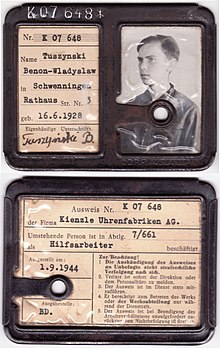Polish decrees

Polish decrees, Polish directives or decrees on Poles (
Purpose


The decrees were an important step towards
Specific content

Polish workers were required to wear a clearly visible letter "
Punishments for disobedience for Polish workers included being sent to a
Maintain the purity of German blood! That applies to both men and women! Just as it is considered the greatest disgrace to become involved with a Jew, any German engaging in intimate relations with a Polish male or female is guilty of sinful behavior. Despise the bestial urges of this race! Be racially conscious and protect your children. Otherwise you will forfeit your greatest asset: your honor![3]
Application

After the invasion of Poland, Poles over the age of 14 living in the General Government were subject to compulsory labor.[4] In 1939 there were about 300,000 prisoners from Poland working in Germany;[5] Already in 1944 there were about 2,8 m Polish Zivilarbeiters in Germany (approximately 10% of Generalgouvernement workforce)[6] and a similar number of workers in this category from other countries.[5] Forced laborers worked in agriculture, but also manufacturing.[7]
Where voluntary recruitment failed to yield a required number of workers, penalties were issued on communities that failed to provide workers (confiscation of property, fines); later, manhunts were organized (see łapanka).[8]
Workers' lives were almost totally regimented.[1]: 74
In December 1941 the decrees were supplemented by Polish Criminal Regulation (Polenstrafrechtsverordnung), which introduced
See also
Notes
- ^ ISBN 978-0-521-47000-1.
- ^ a b "Poles: Victims of the Nazi Era". United States Holocaust Memorial Museum. Archived from the original on 3 March 2013. Retrieved 24 May 2013.
- ISBN 978-0-521-47000-1.
- ISBN 978-0-8018-6493-3.
- ^ a b John C. Beyer; Stephen A. Schneider. "Forced Labor under Third Reich - Part 1" (PDF). Nathan Associates Inc. Archived from the original (PDF) on 19 March 2009. Retrieved 17 July 2009. and John C. Beyer; Stephen A. Schneider. "Forced Labor under Third Reich – Part 2" (PDF). Nathan Associates Inc. Archived from the original (PDF) on 19 March 2009. Retrieved 17 July 2009.
- ^ A. Paczkowski, Historia Powszechna/Historia Polski, Wydawnictwo Naukowe PWN, Warszawa 2008, tom 16, p. 28
- ISBN 978-1-84545-013-7.
- ISBN 978-0-7456-1730-5.
- ISBN 978-0-521-47000-1.
External links
- (in German) Die "Polenerlasse" vom 8. März 1940 (The "Poland edicts of 8 März 1940 March 1940)
- Poster: "Poles! Recently were executed: Zlosnik Josef (for aggravated assault on his employer), Sikora Stanislaus (for rape), Domagala Wladyslaw (for aggravated burglary), Pesko Josef (for arson). You shall recognize by this: Who is working will live well in Germany! Who does not want to work will be forced to do so! Who is violating the German war and moral laws will be hanged!"
